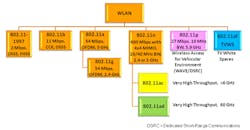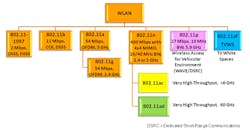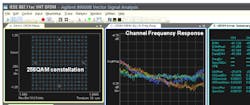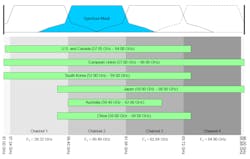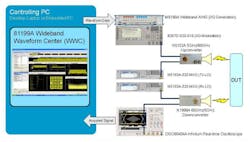What’s The Difference Between IEEE 802.11ac And 802.11ad?
This file type includes high resolution graphics and schematics when applicable.
Originally, equipment based on the IEEE 802.11 wireless-local-area-networking (WLAN) standards (first IEEE 802.11a and b and 802.11g in 2003) was used as a means of delivering simple web browsing and e-mail connectivity “on the road”—in airports, hotels, Internet cafes, and shopping malls. Since then, such equipment has moved firmly into the home and home-office environment. Multiple devices now operate in connection to each other: computers, smartphones, tablets, printers, game consoles, media servers, scanners, and more. In addition, we want access to all of our stored material—data, pictures, whatever—from devices as small as a smartphone or as large as the screen in an auditorium—and to be able to share it with friends and colleagues instantly. We also want speeds that match a wired gigabit LAN connection, without the cables. The IEEE 802.11x standards are steadily evolving to meet all of these desires and demands (Fig. 1).
1. This graphic provides an overview of the IEEE 802.11x standards family.
IEEE 802.11n was introduced in 2009, improving the maximum single-channel data rate from the 54 Mb/s of IEEE 802.11g to more than 100 Mb/s. It also introduced multiple-input multiple-output (MIMO), or “spatial streaming,” communications. As many as four separate physical transmit and receive antennas carry independent data, which is aggregated in the modulation/demodulation process. Projections call for even higher data throughput requirements in future home and office applications. To cater to these, two new IEEE project groups have been formed with the goal of providing “very high throughput” (VHT).
Working Group TGac hopes to specify IEEE 802.11ac as an extension of 802.11n, providing a single-link minimum of 500-Mb/s and 1-Gbit/s overall in the 5-GHz band. Meanwhile, Working Group TGad and the Wireless Gigabit Alliance (WiGig) jointly proposed IEEE 802.11ad, which is targeting short-range speeds to 7 Gb/s in approximately 2 GHz of spectrum at 60 GHz. It was officially accepted as a standard at the end of 2012.
With the huge number of existing client devices, backward compatibility with current standards using the same frequency range is vital. The goal is for all IEEE 802.11 standards to be backward compatible and for 802.11ac and 802.11ad to be compatible at the medium-access-control (MAC) or data-link layer. They should differ only in physical-layer (PHY) characteristics. Devices could then have three radios: 2.4 GHz for general use (which may suffer from interference), 5 GHz for more robust and higher-speed applications, and 60 GHz for ultra-high-speed operation within a room—as well as support session switching amongst them.
802.11ac
The IEEE 802.11ac physical layer is an extension of 802.11n, thereby maintaining backward compatibility with that existing standard. The theoretical maximum overall data rate for 802.11n is 600 Mb/s using 40-MHz bandwidth with four spatial streams. (Most consumer devices, however, are limited to two streams.) The theoretical 802.11ac maximum data rate is 6.93 Gb/s using 160-MHz bandwidth, eight spatial streams, modulation and coding scheme 9 (MCS9) with 256-state quadrature amplitude modulation (256QAM), and a short guard interval. A more practical maximum data rate for consumer devices might be 1.56 Gb/s, which would require an 80-MHz channel with four spatial streams, MCS9, and a normal guard interval.
2. This is a typical IEEE 802.11ac analysis display.
Both 160-MHz and 80+80-MHz modes are included as optional features in the IEEE 802.11ac standard. However, the first 802.11ac products are using 80 MHz bandwidth and up to 4 antennas. System simulation and test are supersets of existing scenarios. The main additions are the challenges of generating and analyzing higher bandwidths and the split bandwidth modes, and the complexity of the 8x8 MIMO functional test. Figure 2 shows a typical 802.11ac signal as displayed on a vector signal analyzer (VSA).
802.11ad
While IEEE 802.11ac is an extension of the existing 802.11n specification, IEEE 802.11ad represents a completely new paradigm. Today, the 2.4- and 5-GHz wireless bands for the earlier 802.11 standards are heavily congested. They also lack the capacity to deliver the extreme data rates required for emerging business and consumer applications. The multi-gigabit data rates required for uncompressed high-definition multimedia transmissions—including known futures like 4k and 8k digital cinema (3840 x 2160 and 7680 x 4320 pixels respectively) and three-dimensional (3D) video streaming—must be accommodated in a different way.
Ultimately, data capacity is tied to modulation bandwidth. And extreme data capacity calls for a large spectrum allocation. The simplicity of high-volume manufacturing demands that this modulation bandwidth should be a small percentage of the transmission frequency. The global unlicensed band that already exists at around 60 GHz (where multi-gigahertz modulation bandwidths are practical) meets that requirement.
Because 60-GHz transmission suffers from large attenuation when propagating through physical barriers, this usage model is different from the other IEEE 802.11 standards. Low-power transmissions will not propagate very far. This is considered an advantage, as it reduces the likelihood of co-channel interference and increases the potential density for frequency re-use. Another perceived advantage of limited range is the reduced opportunity for "theft" of protected content by eavesdropping on nearby transmissions.
The unlicensed frequency allocations at around 60 GHz in each region do not match exactly. But there is substantial overlap. At least 3.5 GHz of contiguous spectrum is available in all regions that have allocated spectrum.
The ITU-R-recommended channelization comprises four channels that are each 2.16-GHz wide. They are centered on 58.32, 60.48, 62.64, and 64.80 GHz. As Figure 3 illustrates, not all channels are available in all countries. Channel 2, which is globally available, is therefore the default channel for equipment operating in this frequency band. In November 2011, this channelization and the corresponding spectrum mask for the occupying signal were approved by ITU-R WP 5A for global standardization.
3. The 60-GHz-band channel plan and frequency allocations are shown by region.
Today, devices and subsystems in the 60-GHz band for consumer technology are a commercial reality, thanks to high-yield, low-cost, micron-geometry components. Multiple-antenna configurations using beam-steering are an optional feature of the specifications. They can be employed to circumnavigate minor obstacles, such as people moving around a room or a piece of furniture blocking line-of-sight transmission. Longer free-space distances (e.g., beyond 10 m) and more substantial obstructions (e.g., walls, doors, etc.) will prevent transmission.
There is, however, a major challenge when it comes to system testing. Component and system design and test at 60 GHz is a well-understood and established science, but its application to high-volume, low-cost devices for the consumer market is new. Tools for millimeter-wave circuit design and simulation, network analysis, signal analysis, and power measurements have been available for years in applications like short-range radar and military communications. IEEE 802.11ad boasts much wider modulation bandwidth than other wireless communications systems. In addition, the physical construction of the devices is unique. The system shown in Figure 4 offers an example of the equipment needed for transmitter and receiver testing.
4. Among the test-equipment solutions targeting these specifications is the IEEE 802.11ad Physical Layer Signal Generation and Analysis System.
In summary, IEEE 802.11ac and 802.11ad both provide much higher data throughputs than their predecessors. Yet they have much different potential uses. IEEE 802.11ac is an evolution of previous WLAN capability. It gives the “unwired office” the ability to compete directly with gigabit wired systems while offering much better layout and connection flexibility. In contrast, IEEE 802.11ad is a new solution that provides ad-hoc short-range connectivity in support of extremely high data rates.
About the Author
Liz Ruetsch
Applications Marketing and Planning Manager, Microwave Communications Division
Liz Ruetsch is Applications Marketing and Planning Manager for the Microwave Communications Division at Agilent Technologies. Ruetsch has worked for Hewlett-Packard Co./Agilent Technologies for the past 18 years, holding a variety of positions in both the Americas Regional Sales Organization as well as the Electronic Measurement Group (EMG) divisions. Ruetsch has earned a BSEE from Rutgers University (1994) and an MBA from the Boston University Executive MBA Program (2006).
